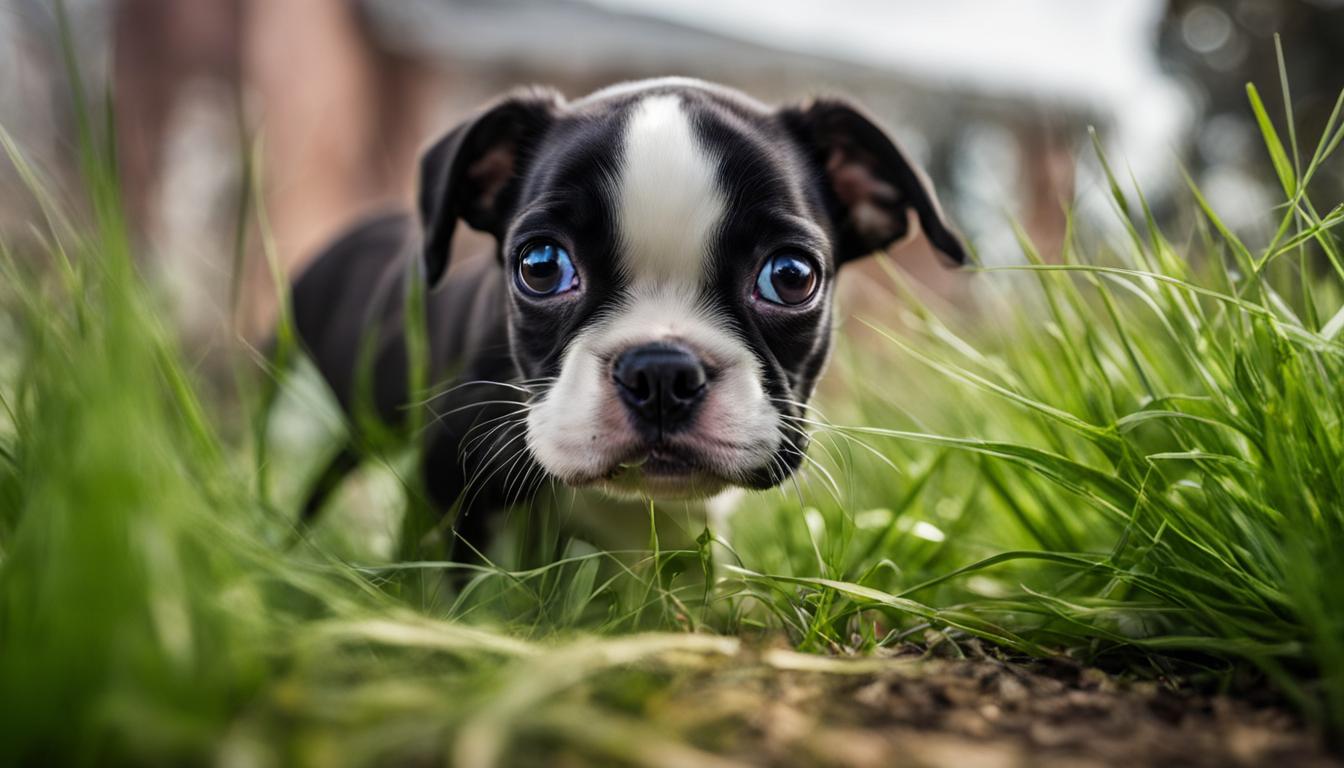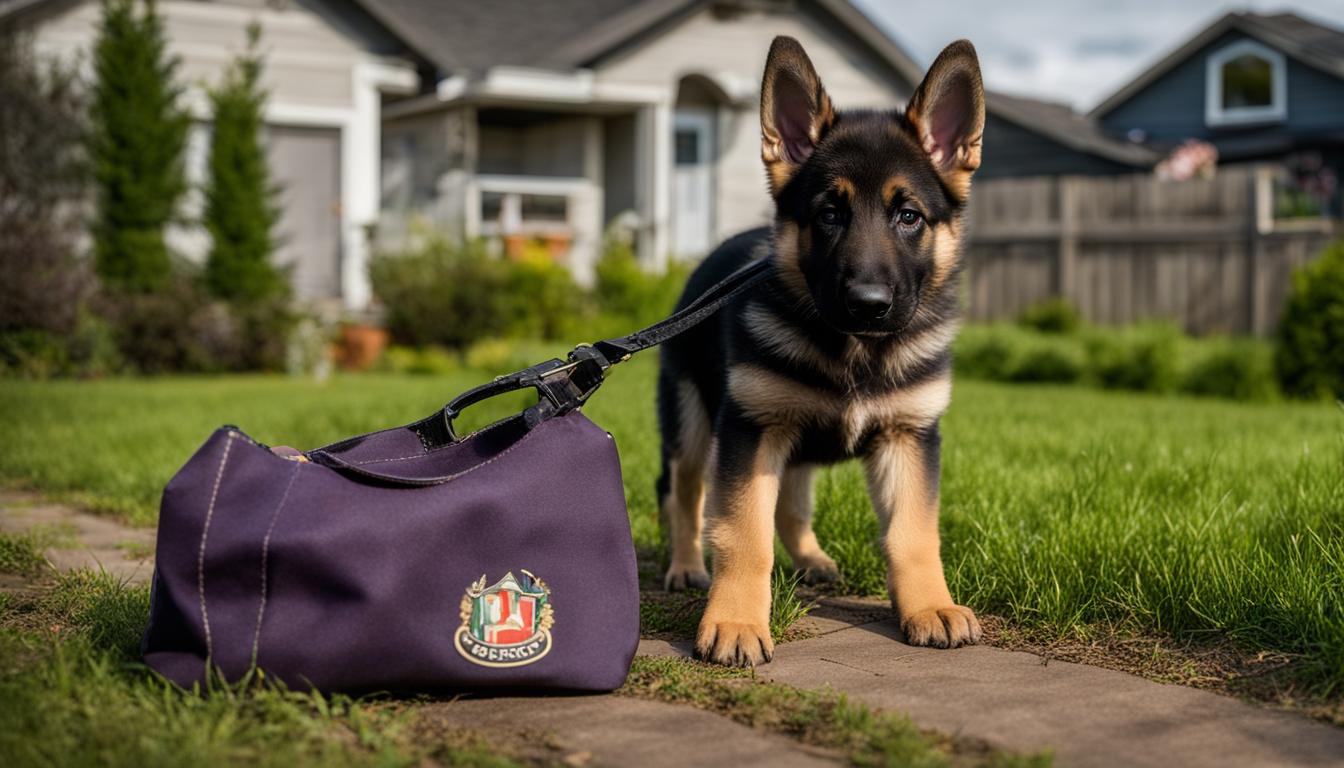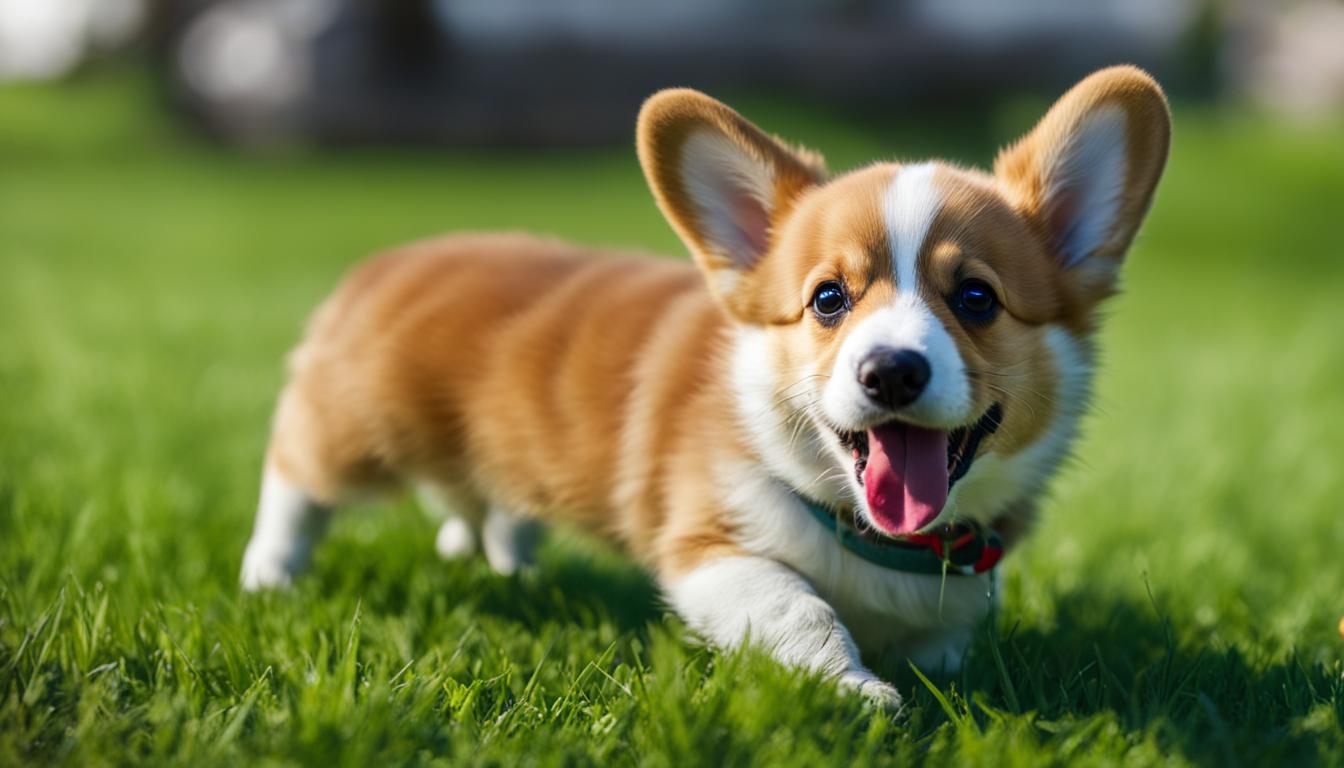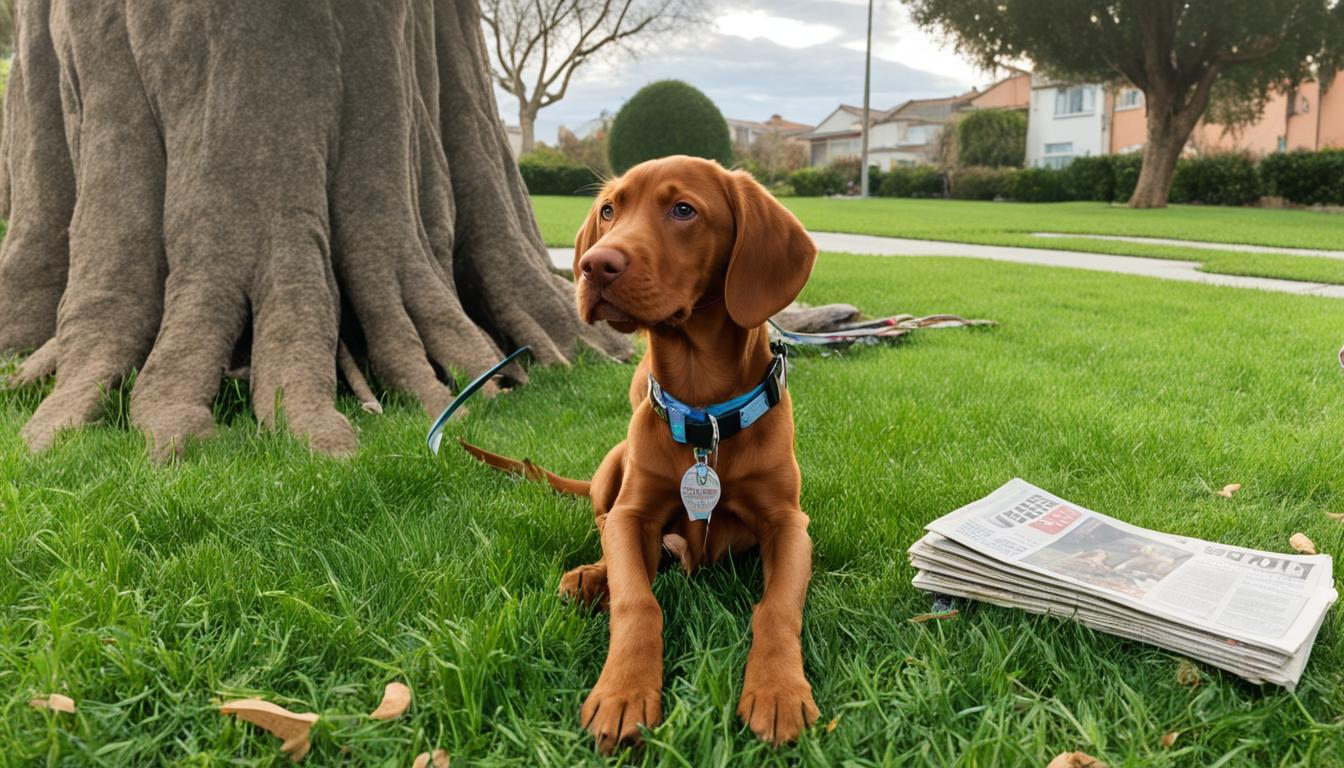Bringing a Boston Terrier puppy into your home is an adventure filled with joy and the occasional challenge—one of the foremost being house training. You’re in luck, though, because with the right puppy potty training tips, you can transform your playful pooch into a disciplined companion in no time.
Effective Boston Terrier house training not only establishes a bond between you and your new friend but also lays down the foundation for a well-mannered adult dog.
Are you ready to navigate the world of dog housetraining techniques that ensure your furry pal becomes the perfect housemate?
Follow this essential guide to understand the nuances of teaching your Boston Terrier the dos and don’ts of potty etiquette, making those messy mishaps a thing of the past.
What Are The Benefits of Potty Training Your Boston Terrier Puppy?
Potty training your Boston Terrier puppy is far more than just a routine—it’s an investment in your future together, yielding significant advantages of house training. The most evident outcome is preventing house soiling, which doesn’t just save your carpets but also defends the deep connection between you and your pet.
| Benefits | Description |
|---|---|
| Maintaining Hygiene | House training keeps your living environment clean and hygienic, reducing the risk of unwanted odors and stains. |
| Reducing Stress | Establishing a potty schedule lessens anxiety for both owner and pet by creating dependable expectations. |
| Enhancing Relationships | A well-trained puppy integrates better into the family, which fosters a strong dog-owner relationship based on trust and communication. |
By teaching your Boston Terrier where and when to relieve themselves, you’re setting the stage for a disciplined and respectful pet. This cornerstone of puppy upbringing is more than beneficial—it’s crucial for a harmonious household. Patience and dedication to this process are paramount, but the rewards are immeasurable. You’ll cultivate a mutual respect and understanding with your canine companion, ensuring that every homecoming is a joy rather than a chore.
A successful house training routine leads to a happier, well-adapted dog and a delighted, proud owner.
- Prevents property damage and maintains a clean home environment.
- Safeguards the emotional bond by reducing frustration over accidents.
- Offers insight into your dog’s health by monitoring potty habits.
Training your Boston Terrier to navigate this aspect of domestic life is part of a broader educational journey that binds you to your furry friend. Embrace the process, and watch as your puppy grows into a reliable and affectionate member of the family.
How to Potty Train a Boston Terrier Puppy (step-by-step)
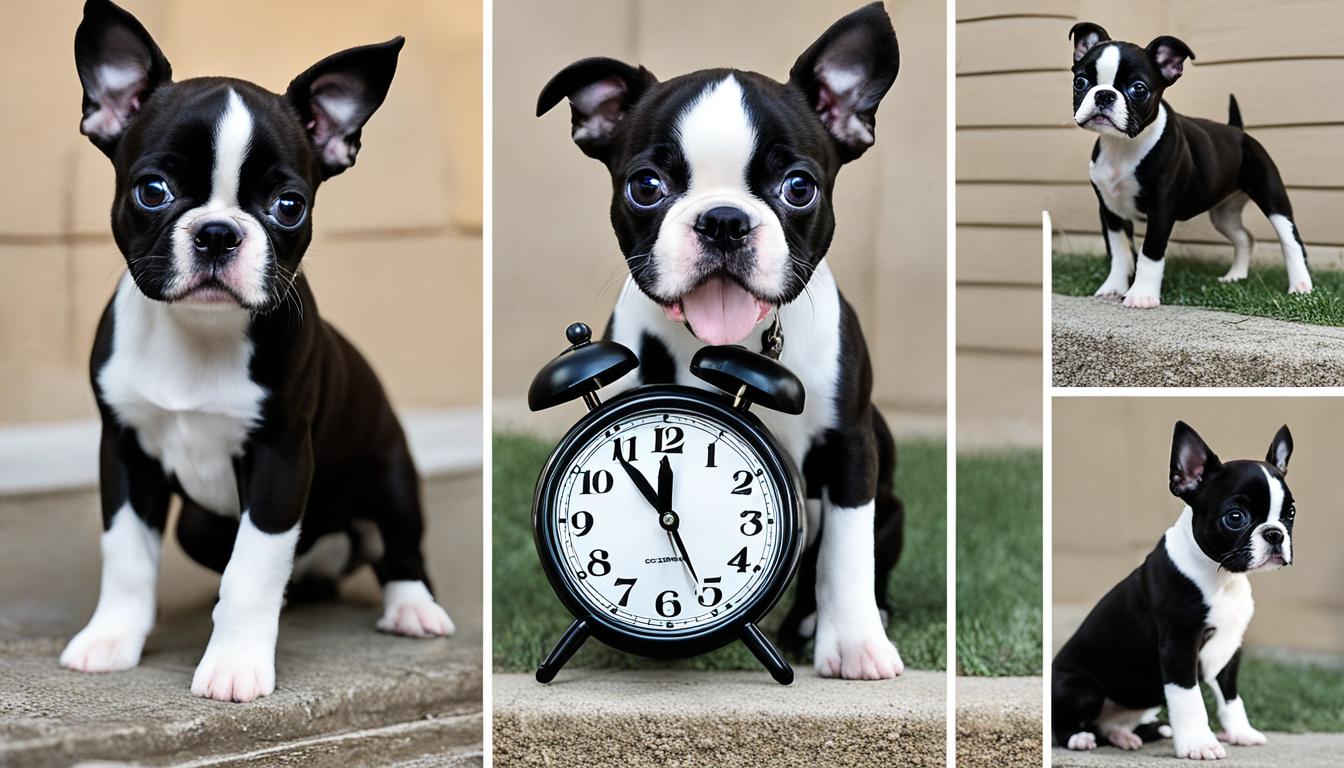
Embarking on the journey of step-by-step potty training your Boston Terrier puppy requires patience and consistency. A carefully crafted potty training schedule, recognizing potty break cues, and an emphasis on accident prevention are crucial elements to achieve success. Follow this comprehensive guide to help your little companion become well-trained in no time.
Step 1: Master The Basics of Potty Training a Puppy
Understanding how puppies learn and communicate is vital. Establish cues for when it’s time for a potty break and consistently use them to build a routine.
Step 2: Choose The Designated Puppy Potty Area
Choose a spot that’s easily accessible for your puppy, and preferably one that can be quickly reached at any time of the day or night.
Step 3: Set a Potty Break Schedule
Align the potty breaks with your puppy’s daily routine, taking into account feeding times, wake-up and bedtime, and after play sessions.
Step 4: Look for Visual Cues Such as Sniffing, Circling, or Whining
Be alert for these potty break cues, which indicate that your puppy needs to go, and respond promptly to prevent accidents.
Step 5: Take Your Puppy Out to The Designated Potty Area Frequently
Young puppies need to relieve themselves often, so ensure regular visits to the designated area to prevent accidents inside the house.
Step 6: Use a Leash and Collar or Harness to Take The Puppy Outside
Using a leash and collar or harness will keep your puppy safe and secure on their way to the potty area and back.
Step 7: Avoid Accidents at All Costs
Keeping a close eye on your puppy, especially after meals and naps, will minimize the chances of accidents within the home.
Step 8: Clean up Any Accidents Thoroughly With an Enzymatic Cleaner
In the case of an accident, it’s essential to completely remove the odor to prevent your puppy from associating that area with elimination.
Step 9: Choose a Specific Word to Use Consistently When Taking Your Boston Terrier Puppy Outside to Potty
Select a cue word like “potty” or “outside” and use it every time, so your puppy can associate the word with the act of eliminating.
Step 10: Stick With a Routine
A consistent routine is key to successful potty training. Stick to the designated times and use positive reinforcement to reinforce good behavior.
Step 11: Confine The Puppy When You Are Unable to Supervise Them
When you’re not around to keep an eye on your puppy, use a crate or a designated area of your home to prevent accidents.
Step 12: Stay Consistent and Patient for Successful Potty Training
Patience is essential, as is a steady approach to training. Each dog learns at their own pace, but with consistency, they will get it right.
Step 13: Focus on Praising Your Puppy for Getting It Right
Celebrate your puppy’s success with lots of praise and perhaps a treat. Positive reinforcement will encourage them to repeat the desired behavior.
Step 14: Gradually Increase The Time Between Potty Breaks
As your puppy grows and gains control, you can start to extend the intervals between visits to the potty area, always mindful of their capacity.
| Age of Puppy | Recommended interval between potty breaks | Tips for Success |
|---|---|---|
| 8-10 weeks | Every 1-2 hours | Supervise closely, as puppies can’t hold for long |
| 10-12 weeks | Every 2-3 hours | Start extending intervals; consistent schedule is key |
| 3-6 months | Every 4 hours | Begin to expect more control, but observe for cues |
| 6 months and up | Every 4-6 hours | Gradually increase as puppy can hold for longer durations |
By adhering to this structured approach, your Boston Terrier puppy will learn where and when it’s appropriate to go potty, laying the foundation for a happy and hygienic home environment.
Equipments You Need Before Starting Potty Training a Boston Terrier Puppy
Embarking on the journey of potty training your Boston Terrier puppy can be a smooth sail if you have the right puppy training supplies. It’s not just about patience and consistency; having the correct potty training tools and housetraining accessories are crucial components for success. Let’s take a look at the essentials needed to effectively potty train your furry friend.
The first and foremost on your shopping list should be a high-quality crate. Your puppy will see this as their personal space – a place of comfort and security. A crate replicates a den-like environment which naturally deters the pup from soiling their area. Ensure the crate is appropriately sized for your Boston Terrier to stand, lie down, and turn around comfortably.
Remember, a crate too large may give your puppy the idea that one corner can be dedicated to potty breaks, which is what we’re trying to avoid.
- Puppy Pads/Paper – For those initial stages or if you’re living in an apartment where quick outdoor access is challenging.
- Enzymatic Cleanser – Accidents will happen, but they don’t have to become a habit if you clean up with an odor-eliminating cleanser.
- Rewards – Delicious treats can go a long way in reinforcing positive bathroom behaviors.
- Leash and Collar/Harness – Safety is key. A secure leash and comfortable collar or harness are vital for those potty excursions outside.
- Dog Gate – Confine your puppy safely to a designated area of the house to prevent mishaps as they learn.
With these supplies at hand, you’re setting yourself—and your adorable Boston Terrier puppy—up for success. Remember, the right tools not only ease the potty training process but also contribute to a positive learning experience for both you and your puppy.
Indoor Potty Training Vs. Outdoor Potty Training
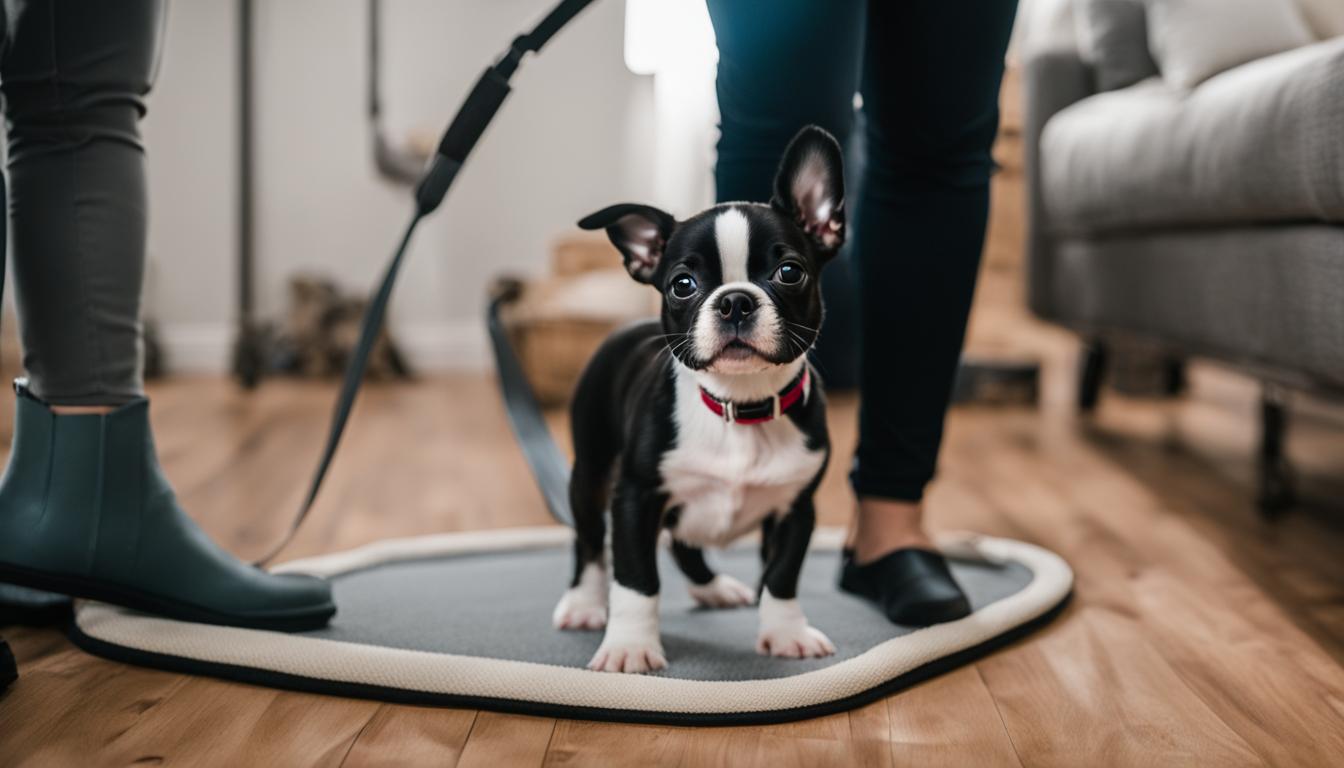
Whether you’re living in a metropolitan high-rise or a suburban home with a backyard, the decision between indoor toilet training and outdoor potty habits for your Boston Terrier puppy is pivotal. Balancing factors such as your personal schedule and living quarters are key when choosing the right housebreaking techniques for your furry friend.
Indoor Toilet Training: Ideal for city dwellers or those facing harsh weather conditions, indoor potty training utilizes puppy pads enabling your Boston Terrier to do their business without stepping outside. This could also be a smart choice for puppies who haven’t finished their vaccinations, limiting their exposure to outdoor elements and potential health risks.
Outdoor Potty Habits: Favored for its natural alignment with a dog’s instincts, outdoor potty training encourages your Boston Terrier to relieve themselves in a natural setting, which can reinforce a straightforward housebreaking routine. It does, however, require you to have a consistent schedule to let your puppy out throughout the day.
Here’s a quick comparison to help you weigh your options:
| Indoor Training | Outdoor Training |
|---|---|
| Suitable for apartment living | Ideal for houses with yard access |
| Convenient during inclement weather | Aligns with puppies’ natural preferences |
| Useful for unvaccinated puppies | Requires consistent access to outdoor space |
| May need transition to outdoor habits later | Encourages clear housebreaking routine |
No matter which method you choose, consistency and patience are the cornerstones of successful potty training. With the right approach and understanding, your Boston Terrier will soon master their indoor or outdoor potty habits.
Crate Training Vs. Pad Training a Boston Terrier Puppy
Deciding on the best approach to potty training your Boston Terrier puppy can be challenging. Understanding the crate training benefits and the convenience of puppy pad training, can help you choose a method that’s right for both your lifestyle and your puppy’s needs. Let’s weigh in on these popular Boston Terrier training methods and see how they can serve you and your furry friend.
Crate training taps into a dog’s natural inclination for a safe and clean resting area. By using a crate, you’re providing your puppy with a personal space where they’re unlikely to have an accident due to their instinct to keep their den clean. Benefits of crate training extend beyond potty training; it also aids in reducing separation anxiety and establishing a routine for your puppy.
In contrast, puppy pad training might be more suitable if you’re living in an apartment or can’t frequently take your dog outside. Pads can be placed in a specific area of your home, allowing your Boston Terrier to learn to go in the right spot. It’s helpful for owners with hectic schedules, though transitioning to outdoor potty training later on can be another step in your training process.
| Crate Training | Pad Training |
|---|---|
| Utilizes natural instincts | Convenient for indoor use |
| Helps prevent separation anxiety | Ideal for owners with busy schedules |
| Encourages a clean sleeping area | Easy setup and maintenance |
| May require more frequent trips outside | May lengthen the transition to outdoor potty training |
Whether you opt for crate or pad training, remember that consistency is key. Stick to a schedule, monitor your Boston Terrier’s behavior, and control their diet to minimize accidents. Always reinforce positive behavior with praise and rewards while addressing any accidents with proper cleaning methods to deter repeat occurrences.
The choice between crate and pad training isn’t always clear cut and may evolve with your puppy’s development or your own circumstances. Listen to your Boston Terrier, and adapt the training method as needed for the best potty training experience.
Frequently Asked Questions About Potty Training a Boston Terrier Puppy
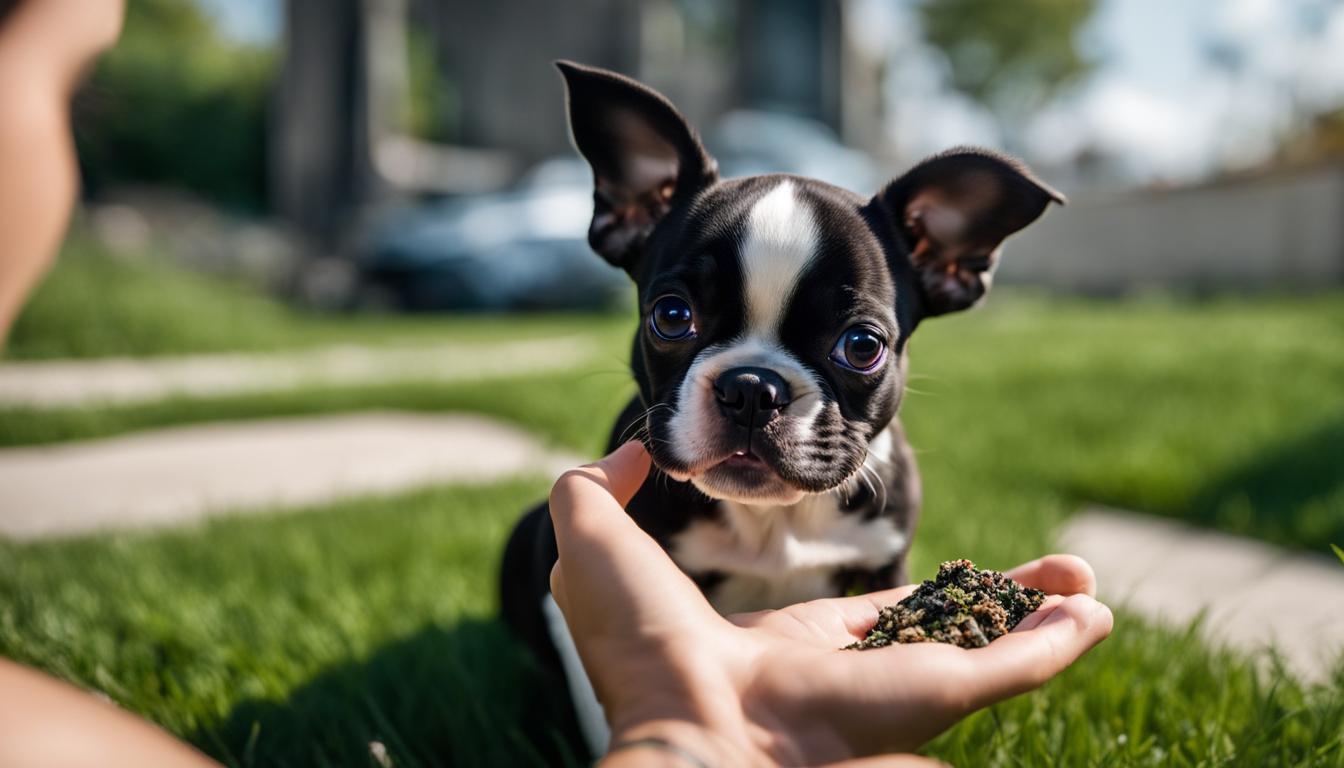
Navigating the intricacies of housetraining your Boston Terrier puppy can often lead to a flurry of questions. Understanding the potty training duration, addressing housetraining challenges, and using potty training rewards effectively are crucial elements for achieving success. Let’s tackle some of the most common queries that might arise during this process.
How Long Does It Typically Take to Potty Train a Boston Terrier Puppy?
The duration of potty training can vary widely from one Boston Terrier puppy to another. Factors such as training techniques, consistency, and the individual puppy’s temperament play a significant role. Typically, a span of a few weeks to several months can be expected for your puppy to be fully house trained.
What to Do if Your Boston Terrier Puppy Won’t Pee Outside The House?
If your puppy is hesitant to pee outdoors, ensure you are creating a consistent routine that includes frequent trips outside, especially after meals and naps. Gradually increase the time spent outside so that your puppy gets comfortable with the environment. Rewards after successful outdoor elimination can also encourage your pup to pee outside.
Should You Use Treats When House Training a Boston Terrier Puppy?
Yes, treats are a powerful form of positive reinforcement during house training. Giving your puppy a treat immediately after they go potty outside can help them make positive associations with the act, speeding up the training process.
Is It Better to Use Puppy Pads or Go Straight to Outdoor Potty Training for a Boston Terrier Puppy?
This decision often depends on your specific living situation and daily routine. Puppy pads can be a practical short-term solution for apartment dwellers or during extreme weather conditions. However, transitioning to outdoor potty training as soon as feasible can be more beneficial in the long run.
What Should I Do if My Boston Terrier Puppy Does Not Seem to Be Learning to Potty Train Correctly?
Persistence is key. Revisit your training routine and ensure it’s consistent. It’s also wise to rule out any potential medical issues with a vet check-up. Offer plenty of opportunities for outdoor bathroom breaks and rewards for proper behavior.
What Should I Do if My Boston Terrier Puppy Starts Having Accidents in The House?
Begin by thoroughly cleaning the accident spots to remove odors that might lure your puppy back. Reassess and tighten up your training schedule, and consider if there are any new stressors or changes in the environment that may have disrupted your puppy’s routine.
What Are Some Common Mistakes That Are Made When Potty Training a Boston Terrier Puppy?
Common mishaps include lack of supervision, inconsistent routines, and responding negatively to accidents. Stay positive and maintain a strict schedule to avoid these housetraining challenges.
What Are Some Potential Consequences of Not Potty Training a Boston Terrier Puppy?
Failure to train can lead to persistent accidents in the home, which could damage your property and weaken the bond between you and your puppy. It might also result in chronic stress for both the pet and the owner.
What Can I Do to Help My Boston Terrier Puppy Feel More Comfortable Going Potty Outside?
Repeated, positive experiences outdoors are key. Engage in playtime and offer treats and affection consistently after your puppy eliminates outside. This will help them associate good feelings with going potty outdoors.
How Old Does My Boston Terrier Need to Be Before I Can Start Potty Training?
Potty training can begin as soon as your Boston Terrier puppy arrives at your home, typically around 8 weeks of age. Early training can set the stage for good habits as your puppy grows.
How Often Should I Take My Boston Terrier Puppy Outside to Go Potty During The Day?
The general rule of thumb is to take your puppy outside to potty once every hour for each month of age. So, a two-month-old puppy should be going outside every two hours. Keep in mind that puppies will need to go out more frequently during times of play or right after eating or drinking.
What Should I Do if My Boston Terrier Puppy Has an Accident Inside During Potty Training?
Avoid scolding or punishing your puppy as it can create anxiety and fear. Clean up the accident thoroughly with an enzymatic cleaner to remove the scent. Reflect on the incident to prevent future accidents—did you miss a cue, or was there a change in the routine?
| Challenge | Strategy | Outcome |
|---|---|---|
| Puppy won’t pee outside | Increase outdoor time, use quick returns | Comfort with outdoor elimination |
| Puppy has frequent accidents | Adjust schedule, supervise more closely | Reduction in indoor accidents |
| Puppy seems anxious outside | Positive reinforcement, gradual exposure | Increased outdoor comfort and routine |
| Inconsistent potty training | Create a consistent routine, use reminders | A more predictable potty schedule |
Last Thoughts on Boston Terrier Puppy Potty Training
Embarking on the adventure of potty training your Boston Terrier puppy may seem daunting at first, but with the right mindset and approach, it becomes a journey of growth for both you and your furry friend.
The key to successful puppy housetraining lies in your ability to remain patient and consistent throughout the process. Puppies, much like children, learn best within the structure of a regular routine complemented by clear and loving communication from their caregivers.
As you wrap up this comprehensive guide, remember that all the time and effort spent now will lead to a harmonious living situation with your Boston Terrier. It’s not just about the potty training wrap-up but setting the foundation for a well-behaved and happy companion moving forward.
Heeding your puppy’s cues, responding with encouragement, and employing the knowledge you’ve gained will inch you closer to the Boston Terrier training conclusion that every owner aspires to achieve—a fully house-trained pet.
Persistence is instrumental, so stick to your training plan even when it gets challenging. Celebrate the small milestones with your pup and maintain a positive spirit. Before you know it, your Boston Terrier will be consistently demonstrating the desirable behaviors you’ve worked so hard to instill.
Here’s to the days ahead, filled with joy and devoid of unwanted messes, as you revel in the accomplishments of potty training your Boston Terrier puppy.

